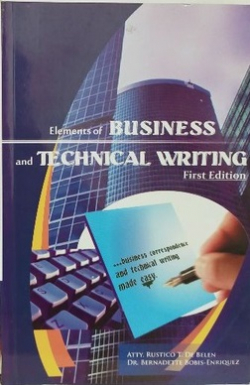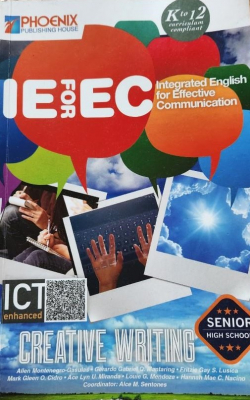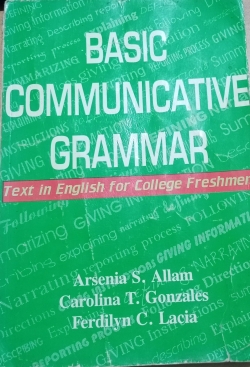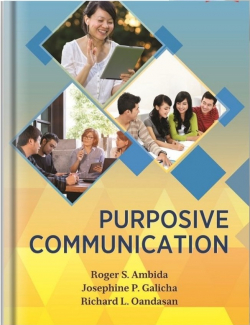Technical writing : a resource guide to writing across disciplines
Buy online ($)
Type
Book
ISBN 13
9786218035560
Category
Filipiniana (Fi)
[ Browse Items ]
Publication Year
2019
Publisher
Lorimar Publishing, Inc., Philippines
Pages
202p.
Subject
Technical writing.
Description
xviii, 202 pages : illustrations, black and white.
Content: Chapter 1: Understanding the nature of technical writing -- Lesson 1. What is technical writing? -- Principles in writing technical writing -- Purposes of technical writing -- Properties of technical writing -- differences between technical writing and creative writing -- Lesson 2. Relevant laws and ethical considerations related to technical writing -- Principles of ethical communication -- Do's of Technical writing -- Don'ts of technical writing -- Lesson 3. The writing process -- Pre-writing stage -- Writing stage -- Re-writing stage -- Chapter 2: Exploring Expository techniques -- Lesson 1. Classification -- What is classification? -- Lesson 2. Definition -- Methods of defining terms -- Lesson 3. Description of a process -- How do you make a paper from a tree? -- Lesson 4. Descriptions of mechanism -- How the refrigerator works? -- How rice cookers work? -- Chapter 3: Writing effective business correspondence -- Lesson 1. Communication in business and organization -- Communication in business -- Communication in organization -- Formal and informal channels of communication -- Lesson 2. Personal and business letters -- Personal letters -- Business letters -- Personal versus Business letters -- Lesson 3. Characteristics and elements of a business letter -- Characteristics of a business letter -- Elements of a business letters -- Lesson 4. Basic and optional parts of a business letter -- Basic parts of a business letter -- Optional parts of a business letter -- Lesson 5. Business letters punctuations and styles -- Punctuations used in business letters -- Business letter style -- Lesson 6. Styles of business letters -- Writing good versus bad-news business letters -- Types of business letters -- Application -- Letter of inquiry -- Letter of reply and response -- Letter of request -- Letter of order -- Lesson 7. Writing memoranda -- What is a memorandum? -- Memorandum versus letter -- Chapter 4: Writing rousing technical reports -- Lesson 1. Fundamental concepts of report writing -- Fundamental concepts -- The K-I-S-S concepts -- Quoting, paraphrasing, and summarizing -- Use of graphic organizers -- Documentation of citation -- Categories of report -- Informal report -- Formal report -- Three levels of reports -- Lesson 2. Classification of technical reports -- Basic classifications or reports -- Article report -- Laboratory report -- Information report -- Special information report -- Research report -- Field report -- Recommendation report -- Incidental report -- Accomplishment report -- Lesson 3. Minutes of the meeting -- Definition of minutes of the meeting -- Format or template of the minutes of the meeting -- sample minutes of the meeting -- Chapter: Evaluating visual rhetoric -- Lesson 1. What; why & where of visual rhetoric -- Definition of visual rhetoric -- Modes of persuasion -- Importance of visual rhetoric platforms of visual rhetoric various media -- Lesson 2. The How of visual rhetoric -- Basic elements of visual rhetoric in hypertext -- Important elements and methods in hypertext -- Steps to create a hyperlink -- How generate visual material -- Queries to consider when choosing fonts -- How colors affect customer's mood and branding -- Visual designer apps and tools -- Design as rhetoric organization -- Lesson 3. Visual rhetoric analytical methodologies -- Steps in conducting visual rhetoric analysis -- How to write your visual analysis paper --- Chapter 6. Maximizing the use of social media and electronic communication in the 21th century -- Lesson 1. Embracing new means of communication -- History of social media and electronic communication -- Why use social media? -- How to get the most out of social media -- Classification of social media -- Content worth sharing -- The apps and social networking sites -- Image sharing -- Mobile devices as one's total life package -- Lesson 2. Social media and technical documentation -- Social media platforms and how you can use them in technical writing -- Challenges and opportunities -- Lesson 3. The best and worst of both social media and electronic communication -- Staying secure in digital world -- Cyber crime cases -- Cyber crime technology -- How to be safe in cyberspace -- Common internet problems and their solutions.
Content: Chapter 1: Understanding the nature of technical writing -- Lesson 1. What is technical writing? -- Principles in writing technical writing -- Purposes of technical writing -- Properties of technical writing -- differences between technical writing and creative writing -- Lesson 2. Relevant laws and ethical considerations related to technical writing -- Principles of ethical communication -- Do's of Technical writing -- Don'ts of technical writing -- Lesson 3. The writing process -- Pre-writing stage -- Writing stage -- Re-writing stage -- Chapter 2: Exploring Expository techniques -- Lesson 1. Classification -- What is classification? -- Lesson 2. Definition -- Methods of defining terms -- Lesson 3. Description of a process -- How do you make a paper from a tree? -- Lesson 4. Descriptions of mechanism -- How the refrigerator works? -- How rice cookers work? -- Chapter 3: Writing effective business correspondence -- Lesson 1. Communication in business and organization -- Communication in business -- Communication in organization -- Formal and informal channels of communication -- Lesson 2. Personal and business letters -- Personal letters -- Business letters -- Personal versus Business letters -- Lesson 3. Characteristics and elements of a business letter -- Characteristics of a business letter -- Elements of a business letters -- Lesson 4. Basic and optional parts of a business letter -- Basic parts of a business letter -- Optional parts of a business letter -- Lesson 5. Business letters punctuations and styles -- Punctuations used in business letters -- Business letter style -- Lesson 6. Styles of business letters -- Writing good versus bad-news business letters -- Types of business letters -- Application -- Letter of inquiry -- Letter of reply and response -- Letter of request -- Letter of order -- Lesson 7. Writing memoranda -- What is a memorandum? -- Memorandum versus letter -- Chapter 4: Writing rousing technical reports -- Lesson 1. Fundamental concepts of report writing -- Fundamental concepts -- The K-I-S-S concepts -- Quoting, paraphrasing, and summarizing -- Use of graphic organizers -- Documentation of citation -- Categories of report -- Informal report -- Formal report -- Three levels of reports -- Lesson 2. Classification of technical reports -- Basic classifications or reports -- Article report -- Laboratory report -- Information report -- Special information report -- Research report -- Field report -- Recommendation report -- Incidental report -- Accomplishment report -- Lesson 3. Minutes of the meeting -- Definition of minutes of the meeting -- Format or template of the minutes of the meeting -- sample minutes of the meeting -- Chapter: Evaluating visual rhetoric -- Lesson 1. What; why & where of visual rhetoric -- Definition of visual rhetoric -- Modes of persuasion -- Importance of visual rhetoric platforms of visual rhetoric various media -- Lesson 2. The How of visual rhetoric -- Basic elements of visual rhetoric in hypertext -- Important elements and methods in hypertext -- Steps to create a hyperlink -- How generate visual material -- Queries to consider when choosing fonts -- How colors affect customer's mood and branding -- Visual designer apps and tools -- Design as rhetoric organization -- Lesson 3. Visual rhetoric analytical methodologies -- Steps in conducting visual rhetoric analysis -- How to write your visual analysis paper --- Chapter 6. Maximizing the use of social media and electronic communication in the 21th century -- Lesson 1. Embracing new means of communication -- History of social media and electronic communication -- Why use social media? -- How to get the most out of social media -- Classification of social media -- Content worth sharing -- The apps and social networking sites -- Image sharing -- Mobile devices as one's total life package -- Lesson 2. Social media and technical documentation -- Social media platforms and how you can use them in technical writing -- Challenges and opportunities -- Lesson 3. The best and worst of both social media and electronic communication -- Staying secure in digital world -- Cyber crime cases -- Cyber crime technology -- How to be safe in cyberspace -- Common internet problems and their solutions.
Biblio Notes
Includes bibliographical references.
Number of Copies
3
| Library | Accession No | Call No | Copy No | Edition | Location | Availability |
|---|---|---|---|---|---|---|
| Main | 860 | Fi 808.066 R7107 2019 | 1 | Yes | ||
| Main | 868 | Fi 808.066 R7107 2019 | 2 | Yes | ||
| Main | 1023 | Fi 808.066 R7107 2019 | 3 | Yes |



